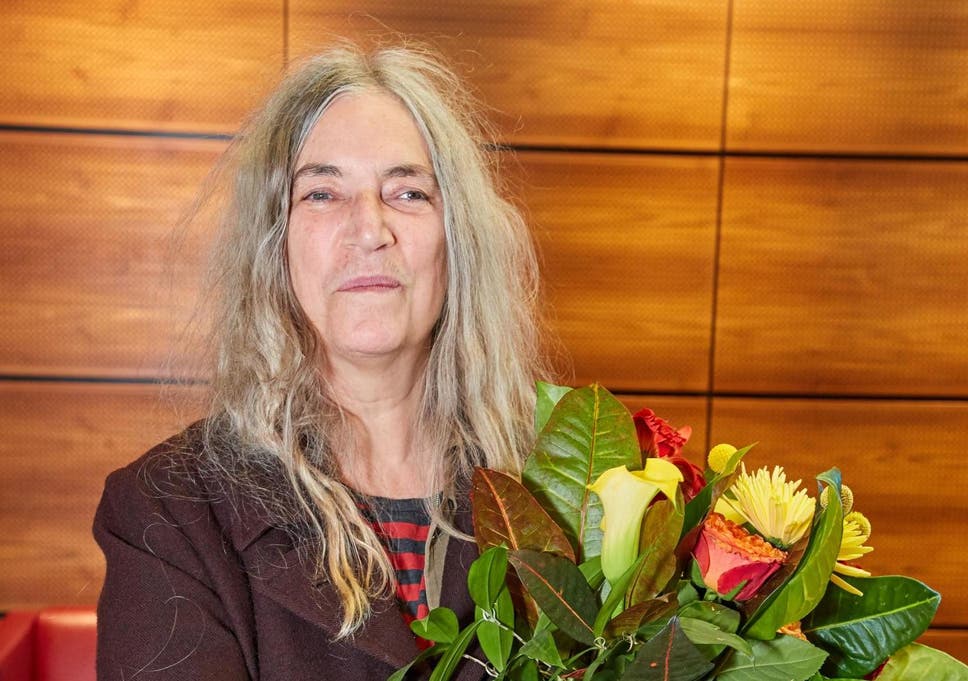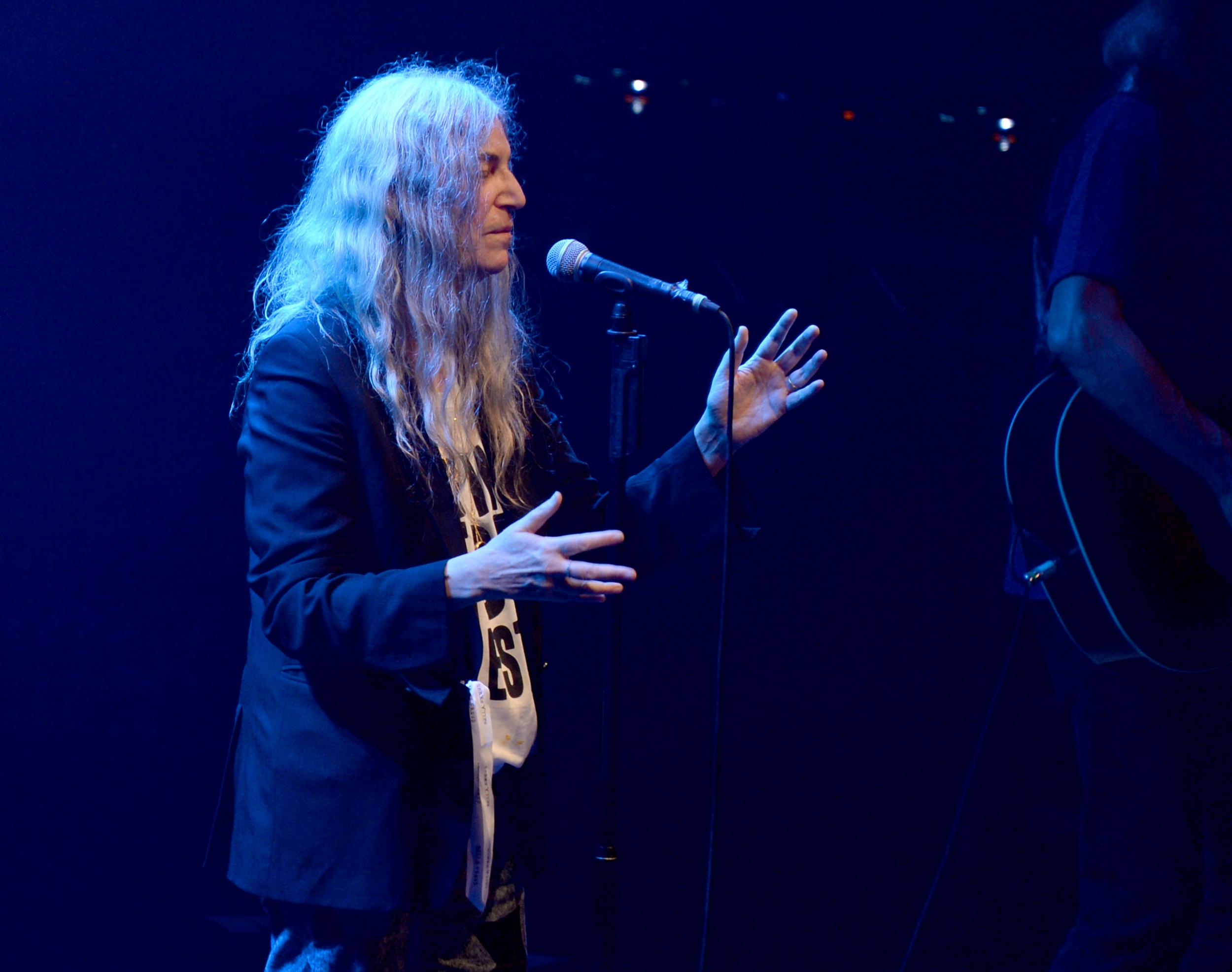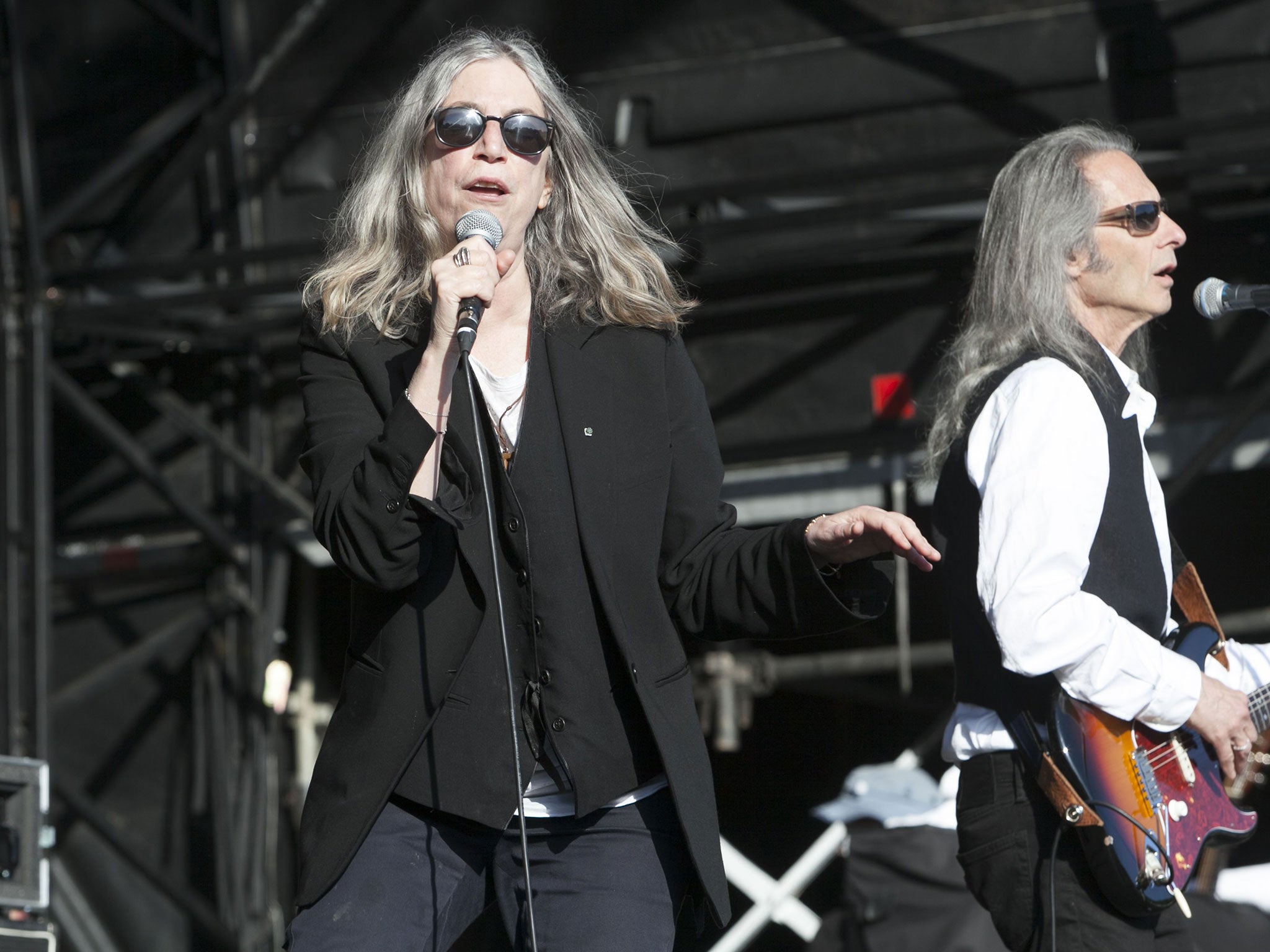
It is 44 years since Patti Smith released her debut album Horses, a volcano of a record that was not just startlingly vivid and assured for a debut but also a genre-busting game changer. With its boundary-crossing blend of Sixties rock’n’roll, scratchy punk spirit and Smith’s visionary lyrics, it influenced (and continues to influence) generations of musicians, sounding nearly as fresh and fierce today as on its release. And it heralded the start of a long career that sees her continue to headline festivals and sell-out tours today, and had her crowned “the godmother of punk”.
Not that such things are important to the 72-year-old Smith: “I’ve been called so many different labels, and I’ve been in and out of fashion, and I don’t care: I just do my work,” she says over the phone from New York, in an interview to discuss her latest project. It’s a poetry-soundscape record charting the French dramatist and poet Antonin Artaud’s attempt to cure his heroin addiction through a shamanic peyote trip in a remote Mexican canyon in the 1930s.
That’s niche by anybody’s standards. But then Smith has never courted chart hits or fame for fame’s sake – although she did make the top five in the UK with the enduring classic “Because the Night”, her recasting of a Bruce Springsteen song, in 1978, and followed it up with her most commercial album, Wave (1979), which included one of her most loved songs, “Dancing Barefoot”. But in 1980, she backed away from the pop world, got married – to MC5 guitarist Fred “Sonic” Smith – and left her beloved New York to move to Michigan and raise two kids, Jackson and Jesse. Smith didn’t release any music for almost a decade.
Her return came in 1988, with the album Dream of Life, which included what has become her live anthem, “People Have the Power” – a track which should be cheesy, yet winds up gloriously rousing when sung by thousands of Smith’s dedicated fans. Even then, it wasn’t a full return to rock’n’roll: although she toured occasionally, there wasn’t another album till 1997’s Peace and Noise. Since then, her career has continued bubbling away fruitfully, if often unexpectedly. There have been albums, most notably the well-received Banga in 2012, and tours, including the Horses 40th anniversary shows in 2015. But there have also been art shows of her photographs, poetry collections, activism, and memoirs (including the wonderful Just Kids about her early life in New York with her then lover, the photographer Robert Mapplethorpe).
It all amounts to a steadily building influence, as generation after generation continue to discover her, fall in love with her – her music, but also her persona. The poet within the punk. And that includes her image: from the hugely influential, super-cool androgyny of the cover of Horses (taken by Mapplethorpe) to her long, natural, unkempt grey locks today, Smith has never been one to give a s*** about how women are “meant” to look, either. Part of the appeal of Patti has always been that she follows her own path.
And her latest project is certainly a testament to that restless, anti-commercial spirit. The Perfect Vision is a triptych of albums blending incantatory poetry with evocative soundscapes. The first record – The Peyote Dance – was released this week.
It’s a fascinating project brimming with pretty wild characters and stories. The three albums look at the questing personal and geographical journeys taken by three French poets – Artaud (1896-1948), Arthur Rimbaud (1854-1891) and René Daumal (1908-1944) – in search of transcendental experiences of the eternal, or the absolute. The sonic landscapes were recorded by the Soundwalk Collective, aka Stephan Crasneanscki and Simone Merli, who have been creating experimental music since 2000. Their work on The Peyote Dance is designed to capture something of the different places the poets travelled to: Mexico, of course, for Artaud; Ethiopia, for Rimbaud; and for Daumal, India.
Crasneanscki and Merli followed in the poets’ footsteps, in order to make field recordings and to collect items, from rocks and branches to earth and sand to local instruments, that could be used back in their studio in New York to recreate a Mexican canyon, or a Himalayan summit.
“Stephan went to very difficult, treacherous places in order to get a beautiful soundscape for me,” Smith comments. “He will photograph the sound of the wind, and the rain.” When visiting the Tarahumara tribe Artaud spent time with, Crasneanscki also undertook a peyote ritual, taking the psychoactive cactus under guidance.
Still, fans of Smith’s work may not be totally surprised by this project. For a start, she first worked with Soundwalk Collective in 2016, setting the poetry of singer Nico to soundscapes. But it’s also clear that she considers herself more poet than pop icon.

Smith began her career dreaming of becoming a poet. She had left her family home in New Jersey, after having a child and giving it up for adoption, at the age of 20, and headed to New York. “I thought most of the poetry readings I went to were boring, and it just wasn’t my scene,” she recalled in an interview with America’s National Public Radio in 2015. “So I started pursuing different venues to perform my poetry… I’d play, like, in a bar that had, like, a little rock band and some little blues band and I’d go on before the blues band.”
It was a baptism of fire, and she became a ferocious performer, shouting down the – often drunk – men who heckled her. But sharing the bill with bands would transform her life: she began collaborating with the guitarist Lenny Kaye (who still plays with her today), who would improvise music alongside her words. Horses grew out of this combination of poetry and spirit, rhythm and music.
Her mission, she said in the same NPR interview, was really “to merge poetry and rock’n’roll … I wasn’t thinking so much of perfection or stardom or any of that stuff. I thought I would do this record and then go back to my writing and my drawing … But Horses took me on a whole different path.”
One of her biggest influences was always Rimbaud; an early poem about him is titled “Dreams of Rimbaud”, and he gets a namecheck in “Land” on Horses. Of Artaud, meanwhile, she comments that she’s been reading him all her life, having discovered his poetry as a teenager. “I was drawn to him because of his visceral language,” she tells me, her voice a low drawl, gravelly but gentle. “His mind was very unique and expansive, somewhat chaotic but extremely articulate. There was a lot to be learned from him.”
Does she find common ground, then, between these writers and pop or punk musicians? “My personal definition of punk rock was always freedom,” she tells me. She speaks slowly, carefully – measured answers that are turned over before they’re delivered, in order to not seem too pat, too simple. And I can feel just a curling edge of scorn in her voice at any question from me that she deems too pat, too simple. Yet there’s generosity and expansiveness in her answers, too, whenever she gets on a roll with a topic (especially if that topic is the new record, of course).
Smith points out that, in different eras, the essence of punk-rock freedom might be expressed in different ways. “You could say that Mozart was a punk rocker!” she says. “I was just looking at an article today about a [British rock] group called Fat White Family, and I liked very much the things that they were saying, because their whole idea is that punk rock isn’t just reactionary, but is in pursuit of the new, of making space, of not being confined or defined.”
Artaud, Rimbaud and Daumal would all fit that definition, she suggests. “All three of them were very much seeking the new, seeking to topple the gods of the past.”
Smith’s relationship with the French-born, New York-based Crasneanscki began through pure coincidence: they were sitting next to one another on a plane. “We just couldn’t stop talking about music and sound and travelling,” he recalls, and the very next day she came over to his studio to begin working on the Nico project. “We understood each other. She’s an inspiration for me, and a gift.”
The Perfect Vision trilogy came about following the pair’s long, rambling walks through New York, talking poetry. Both of them are extremely serious about it; many would call this seriousness “pretentiousness”. But there’s also something appealingly pure and distilled in the way they talk about these dead poets, and of their searches for internal, eternal truths.
And do any of the writers find their “perfect vision”, I ask Crasneanscki. “Yes, but it comes and goes very quickly, it’s a transient moment,” he answers. “It’s a vision that allows you to see an absolute truth: a space where there is no beginning and no end. But it’s a space we have such a hard time accessing because we are so little in the present.”
For Smith, recording the albums became a process of actually channelling the deceased French dudes. It happens, too, when she’s performing her own music sometimes – she finds herself “channelling the audience”. Which might sound hippie-ish, but anyone who’s seen Smith perform live, on a good day, will know what she’s talking about. She seems to harness a tremendous, collective shared feeling, her concerts becoming uplifting or moving in the way that’s hard to define, but deeply felt.
“It doesn’t always happen, and I don’t do anything special, it’s just you find yourself channelling the people as they maybe channel you. It’s transference of energy. In the act of performing, sometimes you enter into other spheres. I can’t break it down for you,” she adds, just a little testily, as if I’ve asked how a magic trick is done. “It just happens.”
The same thing happened when recording these albums. “After some hours in the studio you find almost a loss of self, you’re entering into another realm,” Smith recalls, adding that it’s been a great journey and learning experience half a century into her career. “You have to approach all three writers without fear, especially as they’re all male voices, European voices… So I had to just not be intimidated by any of that and not feel confined by my own preconceptions – just be like a human can opener, and open everything up!”
Was performing the record physically demanding? “Well yes it’s demanding, because the language isn’t mine so I have to surrender to it, and then journey within it. And you keep pushing and pushing to go further and further. In the end, I feel like I’ve done an opera or something,” she concludes with a slight but throaty laugh.
The Peyote Dance gets its title from Artaud’s now out-of-print book about his Mexican experiences. Artaud suffered from mental health issues throughout his life, and was at this stage, in his late thirties, in the grip of a heroin addiction. He’d heard that he could be healed by the indigenous Tarahumara Indians’ shamanic peyote rites, and after giving some lectures in Mexico City, headed for the Sierra Tarahumara in the Chihuahua region.

“He spent four weeks on horseback with no drugs, in great pain, going down this canyon searching for a shaman who would allow him to do a peyote ceremony in order to get rid of the addiction,” says Crasneanscki. “And it worked.”
The ceremonies brought Artaud “great joy and vision”, he adds. At the end of his life, Artaud wrote about how those days were the “happiest” of his life. Not that you’d necessarily know that from this record, with its whispery soundscapes and ritualistic drums, is often dark, and intense, Smith growling and intoning Artaud’s gut-churning imagery.
Several tracks offer insight into what Artaud’s peyote ceremony entailed: they describe the “Rite of the Black Sun” and the “Rite of the Black Night”. The Tarahumara’s religious practice blends elements of their indigenous faith with Roman Catholicism, and in Artaud’s account, there are descriptions of night-long ceremonies, where men, representing suns and carrying crosses, leap in circles or roll on the ground then “spring up successively like sunflowers”. An anthropological study it is not, but Artaud’s rather feverish verse does provide some record of the practice.
“He beautifully preserved [the Tarahumara’s] rite. He has given us a piece of very important history,” says Smith. And The Peyote Dance also features one new song by Smith, a comparatively pretty and direct folky number, imagining the release of Artaud’s last hours (he spent most of the rest of his life in insane asylums).
Crasneanscki’s own journey to the Tarahumara tribes wasn’t significantly easier than Artaud’s: the region is now one the most dangerous in all of Mexico, thanks to drugs trafficking. “You have to be courageous, and just do what you have to do, and not worry,” says Crasneanscki, zen-like.
Maybe the peyote helps: he, too, took it a trip and describes a powerful experience of interconnectedness. “Suddenly you are understanding yourself not as a human but a living organism in the same way as all those around you, on a molecular level; there’s no more separation between you and the universe.”
The Tarahumara tribespeople were extremely welcoming, he recalls. “When you tell them you are on the trail of a poet who once lived with their father or grandfather, they are very touched by it. People were very kind, and very happy and proud of their culture.” Crasneanscki even met the grandson of the shaman who had cured Artaud of his addiction.
It strikes me that The Perfect Vision is a project ripe and bursting with ideas, even if the audience for challenging poetry, transcendental experiences and found landscape sounds may be rather small. But it’s certainly genre-busting, and in that it also fits Smith’s pursuit of the new, the not-easily-defined. “These three albums don’t really fall into any category,” agrees Smith.
One of the things we spend a lot of time hand-wringing over these days is algorithm culture, where streaming services with their “recommended for you” suggestions can flatten and streamline our creative consumption; despite having all music ever at our fingertips we may be drawn to the addictive hit of the familiar, the playlisted.
How does it look from where Smith is sitting, with a long view on this often fickle industry? How has her accidental profession changed and morphed over the past 50 years?
“I grew up in the Fifties when we had no way to share things, you had to really seek things,” she says, describing how even an Edith Piaf or, later, a Bob Dylan record had to be really hunted out.
“And in some ways, I would hate to think that people are losing their adventurous spirit of seeking things. But on the other hand, a lot of things are made available that weren’t available to me when I was young. You’d only get a chance to see a Godard movie once every 10 years!”
She laughs, acknowledging that every new generation will – must – transform the world for themselves. And that includes music, so there’s no sense worrying too much that streaming services will kill ingenuity, or that the digitisation of music has killed the album.
“They decide how they want to listen to music, how they are going to create music. I’m 72 years old, I’m certainly not going to make a judgment on how a 20-year-old listens to music!” she laughs.
“My only advice is: don’t be a slave to technology – technology should be your servant.”
The Peyote Dance is out on Bella Union, 31 May







